
 |
|
Welcome to the Bananas.org forums. You're currently viewing our message boards as a guest which gives you limited access to participate in discussions and access our other features such as our wiki and photo gallery. By joining our community, you'll have access to post topics, communicate privately with other members (PM), respond to polls, upload photos, and access many other special features. Registration is fast and simple, so please join our community today! If you have any problems with the registration process or your account login, please contact us. |
|
|||||||
| Register | Photo Gallery | Classifieds | Wiki | Chat | Map | Today's Posts | Search |
| Container Grown Banana Plants This forum is for discussions about growing banana plants in containers. |
 Members currently in the chatroom: 0
Members currently in the chatroom: 0
|
|
 |
The most chatters online in one day was 17, 09-06-2009. No one is currently using the chat. |

 Email this Page Email this Page
|
|
|
LinkBack

|
Thread Tools

|
|
|
#1 (permalink) |
|
Join Date: May 2009
Posts: 14
BananaBucks
: 16,173
Feedback: 0 / 0%
Said "Thanks" 0 Times
Was
Thanked 18 Times in 4 Posts
Said "Welcome to Bananas" 0 Times
|
Background: The photo (below) shows a container grown Dwarf Cavendish that is on its third season. This plant suffered storm damage shortly after being moved outside this spring. The “mother” psuedostem died back and had to be progressively cut-back until the corm started to produce a new viable plant. While in “survival mode”, this storm damage plant produced four vigorous pups… ranging in height from 8” to over 30”.
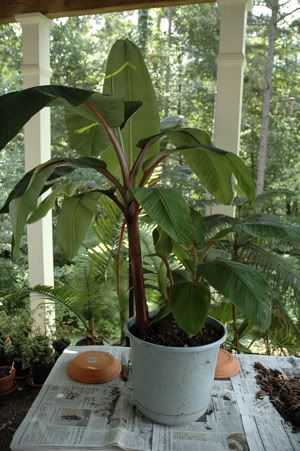 Photo 1 - Dwarf Cavendish Mother Plant and Pups You’ll find that separating and harvesting your banana pups will go much smoother if you prepare a suitable work area and get your potting soil mixed and an assortment of various sized containers assembled. 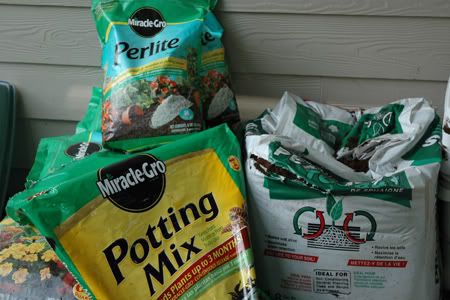 Photo 2 - Potting Mix Components There are numerous posts on this blog regarding what soil mix to use. My preferred blend (by volume) includes: 1/3 Miracle Grow Potting Mix, 1/3 Sphagnum Peat, and 1/3 Perlite. You’ll develop your own preference for organic components over time, making adjustments for your local environmental conditions and your own feeding / watering practices. 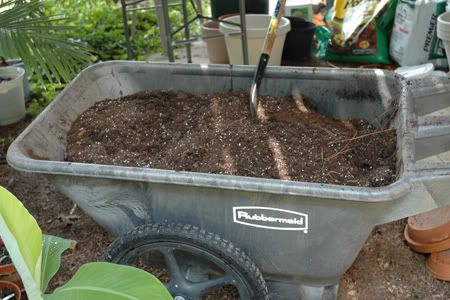 Photo 3 - Potting Mix (Blended) For these Dwarf Cavendish pups that ranged from 8” to over 30” tall, I used a mix of containers ranging in size from about 2 gallons to 10 gallons in size. 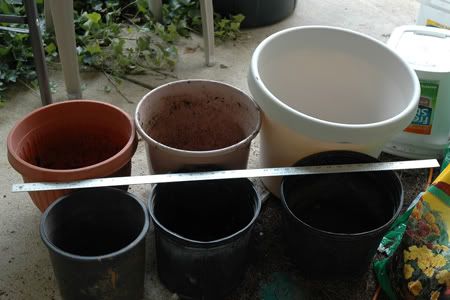 Photo 4 - Assorted Containers (2 Gal to 10 Gal) Work on a potting bench or table where the banana plant growth can extend off the end of the table while rolling and flexing the pot sidewalls. If needed use a long bladed knife around the edges to release the plant from the container… just like taking a cake out of a cake pan.  Photo 5 - Potting Table and Removing Plant for Pup Separation Now is a great time to evaluate your plants existing roots to determine how healthy your soil mix and environmental practices are going. The photo below shows a network of mother plant and pup roots exhibiting good color and vigor. No signs of pathogens or root rot were evident. 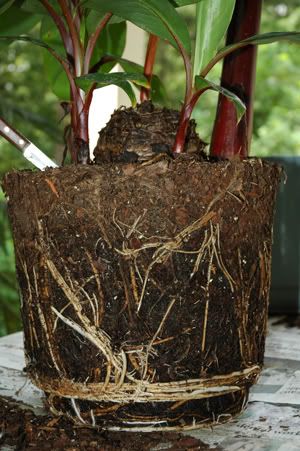 Photo 6 - Evaluate Root Health Chose the first pup you would like to separate and begin to cut a pie-shaped wedge radiating from the corm to the outer circumference of the soil. 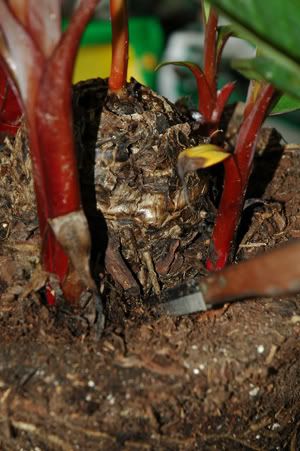 Photo 7 - Separating Pup --- The First Cut Next to the corm, cut vertically (or on a slight diagonal towards corm) to slice the growth connecting the pup to the mother corm. 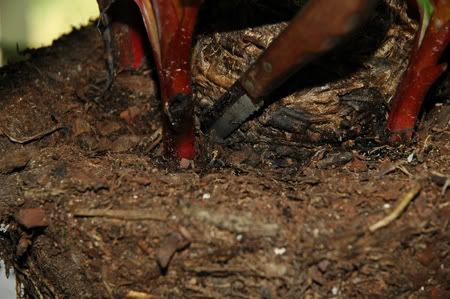 Photo 8 - Separating Pup --- The “Corm” Cut The following diagram from our website links further describes the cut to separate the pup from the mother corm. Banana Gallery - Banana Diagrams If all goes well, you’ll be able to gently pull the pie wedged soil mass along with the first pup away from the mother root mass. 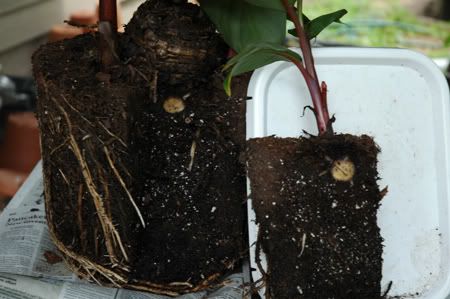 Photo 9 - Separated --- The Pup and Mini- Root Ball Select an appropriate container size and pot the pup at the same height in the soil as it was growing when connected to the mother plant corm. 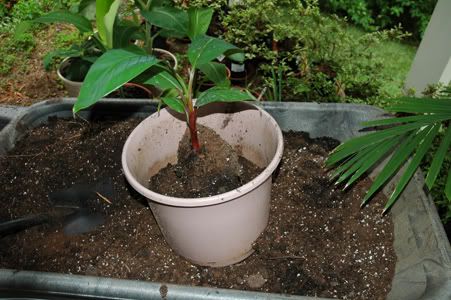 Photo 10 - Potting The Pup --- Same Height as Before Separation Cover with a mulch (I use pine bark nuggets) to prevent your soil mix from drying out too quickly and/or shedding water down the sides of the pot when you water; and finish by protecting your tender plant from damage from your watering hose, etc. by inserting a bamboo stake. 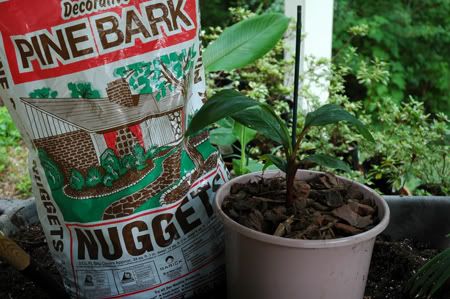 Photo 11 - Cover with Mulch and Protect with a Bamboo Stake You’ve now finished separating your first pup. Follow the same process for all remaining pups. 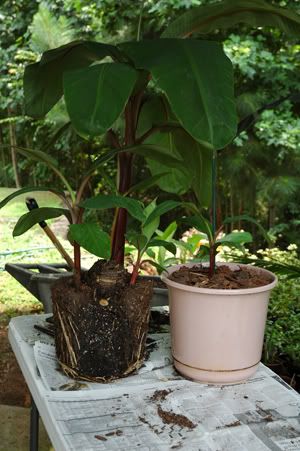 Photo 12 - Mother Plant and First Pup (Side By Side) You might want to leave one (or more) of your vigorous pups attached to the mother corm, particularly if the mother plant has been compromised as was the case with my storm damaged Dwarf Cavendish. This is also an opportunity to up- size your pot for the mother plant.  Photo 13 - Up Size the Pot for the Mother Plant Good luck… Before long you’ll have a rapidly expanding collection of bananas. The following photo shows all the pups and my two Dwarf Cavendish parent plants. I hope this brief tutorial helps other container growers decide when and how to harvest their pups. Hopefully, the “experts” will add their comments and critique to this posting to even further enhance our shared knowledge.  Photo 14 - Separated Pups and Parents |
|
|


|
| Said thanks: |
|
Sponsors |
|
|
#2 (permalink) |
|
My Thumbs are Golden
Location: york,sc
Zone: 8a
Name: alex
Join Date: Apr 2008
Posts: 304
BananaBucks
: 38,999
Feedback: 4 / 100%
Said "Thanks" 184 Times
Was
Thanked 189 Times in 92 Posts
Said "Welcome to Bananas" 249 Times
|
Hi Neukman,
First I have to say very nice Tutorial. But i don't believe that is Dwarf Cavendish. It wouldn't have a red stem or petioles. Here is a pic of my DC, It could very well be Dwarf Red, but not 100% sure. The center Banana is is Dwarf Cavendish along with Zebrina in foreground and Bordelon in the background. alex |
|
|


|
| Said thanks: |
|
|
#3 (permalink) |
 Join Date: Mar 2008
Posts: 3,578
BananaBucks
: 28,234
Feedback: 1 / 67%
Said "Thanks" 3,829 Times
Was
Thanked 1,556 Times in 675 Posts
Said "Welcome to Bananas" 334 Times
|
Alex has made an accurate observation. That is not dwarf cavendish, and it looks like a much better cultivar, either Kru or Dwarf Red, and judging from the petiole arrangement, it may be a Kru.
 |
|
|


|
| Said thanks: |
|
|
#4 (permalink) |
|
Join Date: May 2009
Posts: 14
BananaBucks
: 16,173
Feedback: 0 / 0%
Said "Thanks" 0 Times
Was
Thanked 18 Times in 4 Posts
Said "Welcome to Bananas" 0 Times
|
Sorry guys... my identification was only as good as what it says on the tag from the nursery: Banana 'Dwarf Cavendish' Musa acuminata
If it's mis-labelled so be it... but I really do like the bright red stems! |
|
|


|
|
|
#5 (permalink) | |
|
My Thumbs are Golden
Location: york,sc
Zone: 8a
Name: alex
Join Date: Apr 2008
Posts: 304
BananaBucks
: 38,999
Feedback: 4 / 100%
Said "Thanks" 184 Times
Was
Thanked 189 Times in 92 Posts
Said "Welcome to Bananas" 249 Times
|
Quote:
Don't worry, I agree with Caloosamusa, you probably have a better cultivar than that of the very common, albeit good, Dwarf Cavendish. Plants get mislabeled, and alot of times its hard to identify. I also agree that it could also be Kru or Dwarf Red, But if you want you can do research on both and find what description fits your plant the best. thanks, alex |
|
|
|


|
|
Sponsors |

 Email this Page Email this Page
|
| Currently Active Users Viewing This Thread: 1 (0 members and 1 guests) | |
|
|